Performance testing overview -
Our testing is a little different than most. We combine both synthetic and real-world applications to simulate the types of performance common to the individual products. For motherboards this means that we run roughly six synthetic tests and two real-world. We will be expanding the real-world testing in the near future. But there is more to performance than just the raw numbers. As there are multiple components and sub-components on a motherboard there each item can have a distinct impact on the way the product will perform once you get it in your system. It is important to note not only the actual results but what they mean to you as a potential consumer. We will try to give this information to you.
But we do not just cover the performance aspects that are measurable. We also talk about the components that might not have a direct benchmark. These are items like Audio Quality, ease of use and installation.
Section 1 Subsystems -
Memory;
Memory performance is very important on a motherboard, especially when you have a CPU with multiple cores and threads. If you have slow memory your cores and threads can become starved for data to execute. To test memory performance we run both Sisoft’s SANDRA and Finalwire’s AIDA64. These two combine to not only give us accurate numbers but to validate each other. For testing at stock speeds the memory is hard set to 1333MHz while overclocking testing is done at the highest stable speed for the voltage of 1.65v this is due to the different memory dividers for each CPU. As such, the memory speeds will vary greatly. This means that the overclocked numbers are a little misleading and while they can show a trend are really only included to show if a board has a problem with memory performance at high clockspeeds.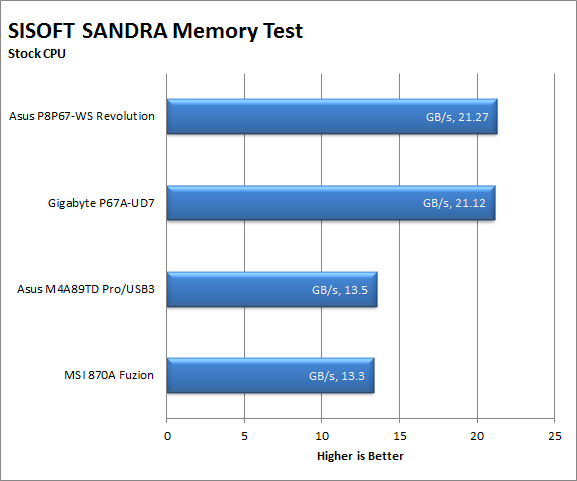
As with most Intel products these days the memory performance is more a function of the CPU than the board. However there are still times when improper trace tuning or a bad BIOS can kill memory performance. This is not the case with the P8P67 WS Revolution the board is solid and so is the memory performance. We see pretty solid numbers here even AIDA64 shows excellent memory bandwidth. This should indicate some solid performance in memory intensive applications like Lightwave 3D, HyperPi, AutoGK etc. At least we should see good performance if we have correspondingly good drive speed.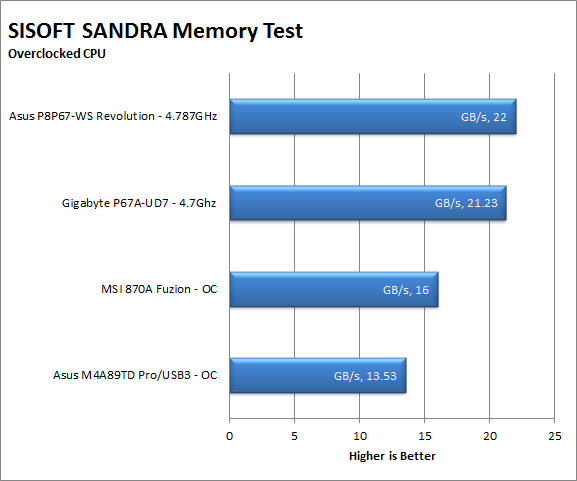
Of course when we overclock things the performance improves. It is kind of interesting to see the jump with such a small increase in memory speed but it is still there.
 |
 |
Drive performance;
Drive performance is also one of the major subsystems that goes to make up the performance of a motherboard. For our testing we use Sandra and AIDA64 again. We only test with single drives for each type of controller present on the motherboard (unless it is a professional product where we will use RIAD 5 and/or 10). We have also begun using a Seagate PS-110 USB 3 external HDD for our USB 3.0 performance. As a side note, we include the overclocked numbers here to make sure (again) that you are not going to see a major drop in performance due to minor instabilities at high clock speeds.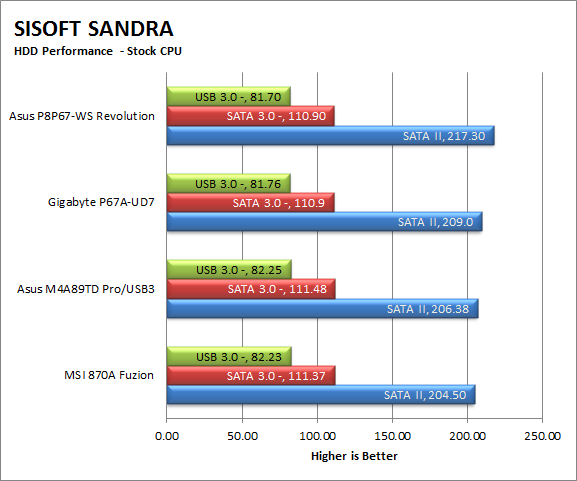
The P8P67 WS Revolution might have one of the faulty SATA controllers, but you would never know it right now. From what we can see the controller is rock solid in its performance and plenty fast. Now with this revision of the chipset we cannot be certain that this level of performance would last but we see no reason that you will not get just as much speed when the new cougar points are out as we see here. This performance level should indicate good speed in the most of the other apps in our testing suite with the biggest performance in test like HyperPi, and AutoGK.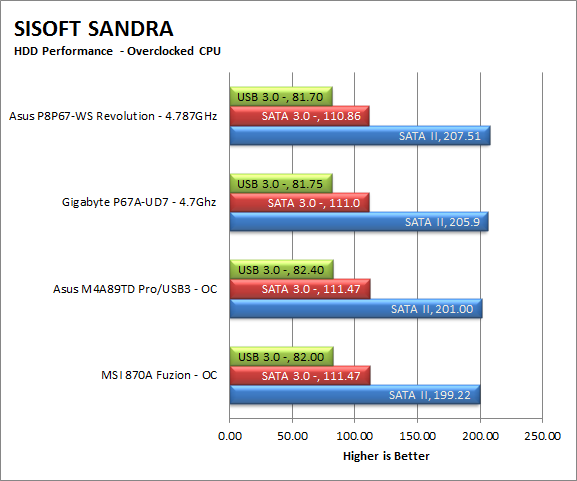
Interestingly enough when we push the system the performance from the HDDs drop, at least this is the case for the SATA II controller when you have an SSD attached. You are still getting good throughput here, but it is slower than stock for sure.
 |
 |
 |
 |
Power;
Power efficiency is another of those misnomers that we get caught up in. We hear about idle states and power gates. But what does that mean to you and I? On the surface having power management that reduces idle power sounds great and can be a benefit to someone that leaves their system on for long periods of time (and inactive) but how a system handles power under load and the delta between the two states is often more important than the idle power usage numbers. We use only P3 Kill A Watt instruments for measuring power. 
The power consumption on most Asus boards is very good. With Sandy Bridge and the P67 we see that continue. Not only do you have a CPU that is using less power, but we are also seeing Asus’ EPU and DIGI+ VRM coming into play for better power efficiency. 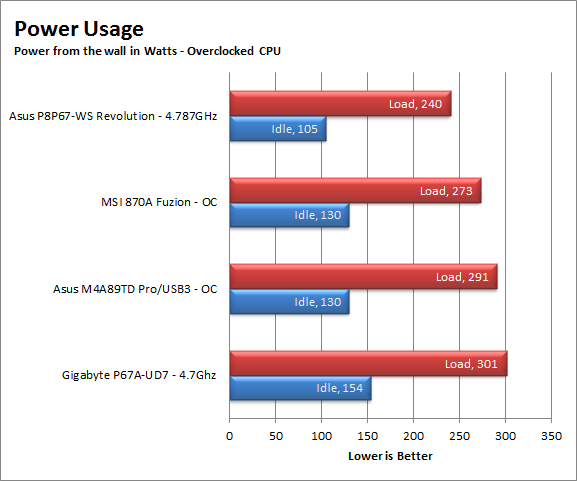
Even overclocked we are seeing a good power envelope. This is even more impressive when you consider the NF200 chip that is on the board. The good power efficiency means longer component life and a lower monthly power bill for you.
Cooling (Board Level);
Board level cooling is an important factor in product performance and longevity. Components like the chipset, VRM modules and even capacitors need to be kept relatively cool to prevent failure. As these parts are made of silicon, they have a thermal breakdown threshold; or melting point. At that temperature the actual transistors built into chip will begin to deform and break down. Granted, the threshold is often very high, but you still need to make sure that components stay away from this level of heat for longer product life. 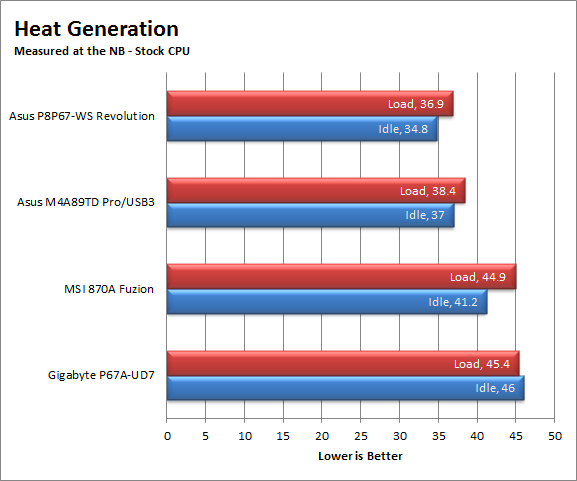
Let’s talk about heat; the Revolution performs well. This is despite the use of an NF200 chip. The heatsinks all stayed in the acceptable range even when overclocked and under load. As with the power efficiency good board level cooling means longer component life, better stability under load and less heat to worry about in your work area. 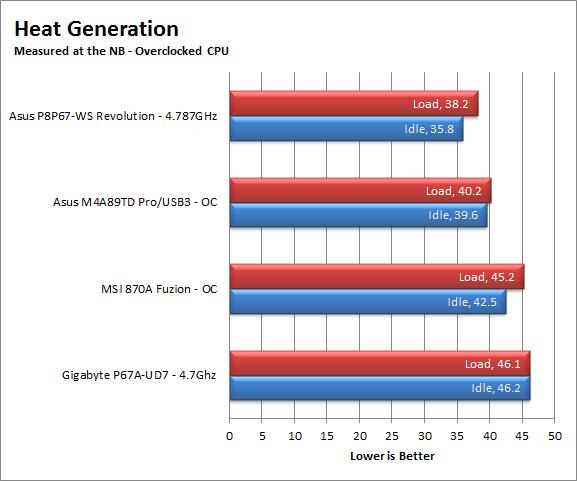
Audio;
Audio is highly subjective. What we find pleasing may sound “off” to you. That is always going to the problem with testing audio; results will vary too widely depending on the tastes of the listener. However, there are ways of measuring the audio output with an objective ear. There is also the issue of audio causing performance issues in gaming and video playback. The reason this is a potential source of concern is that all onboard audio CODECs (Compression/Decompression) are CPU controlled. This means that while the audio chip controls the audio levels and effects of the audio the actual work is done on the CPU. Usually this will not be a problem with today’s powerful CPUs. Even the lower and consumer level products can handle high-end audio these days. But again there is the chance that a bad design or software will hinder your system and performance. On the other side the limits of board space, cost, etc will also prevent the level of audio quality you can get from an add-in board. We test all audio parts with three media types, Movie (DVD), MP3 Music, and Gaming. These are pushed to our Tec On model 55 Tube Amp to see if we can detect any signal issues in the reproduction.
The Audio on the WS Revolution is very good for an onboard CODEC. It is not the same quality as a Xonar or another discrete audio device but it performs very well. This will be a benefit when gaming, watching movies… you know the sort of thing.
Networking;
This one is something that is a requirement anymore. If you have a computer, the chances are good (like 99%) that you are also connected to high-speed internet. With this you need a good and solid LAN chip to make sure that your data flows properly out and back.
As we told you before Asus is moving to put an Intel LAN chip on everything but the very low end. We see that here with a dual LAN configuration. You have one port that is Intel LAN and the other is a RealTek GBe controller. Both do very well and normal file transfers and video streaming. We also did not note any issues with online gaming or web browsing. As more services move to the web solid networking performance is critical, the P8P67 WS gives you that.

 For our second review of 2011 we thought we would take a look at a P67 board (despite all the drama). We chose the Asus P8P67 WS Revolution. This board (like you did not know) is part of Asus’ workstation line up, but that does not mean that it is boring. In fact the WS Revolution is anything but boring. It has been built with the professional enthusiast in mind. You get items like an NF200 chip to help support three way SLI and Crossfire, a 92% power efficiency rating, multiple SATA 3.0 ports (supported by Intel and Marvell), and dual Intel GBe LAN ports. But there is more to it than just the sum of its features. You also get an improved VRM (voltage regulation module), thicker traces for better signal transfer and quite a bit more. With all of this waiting to be tried out, let’s quit the intro chatter and dive into the P8P67 WS Revolution.
For our second review of 2011 we thought we would take a look at a P67 board (despite all the drama). We chose the Asus P8P67 WS Revolution. This board (like you did not know) is part of Asus’ workstation line up, but that does not mean that it is boring. In fact the WS Revolution is anything but boring. It has been built with the professional enthusiast in mind. You get items like an NF200 chip to help support three way SLI and Crossfire, a 92% power efficiency rating, multiple SATA 3.0 ports (supported by Intel and Marvell), and dual Intel GBe LAN ports. But there is more to it than just the sum of its features. You also get an improved VRM (voltage regulation module), thicker traces for better signal transfer and quite a bit more. With all of this waiting to be tried out, let’s quit the intro chatter and dive into the P8P67 WS Revolution.

